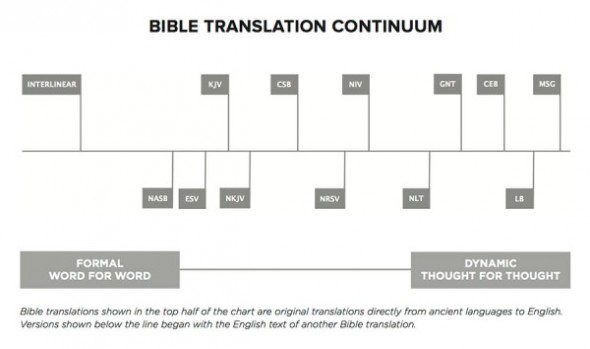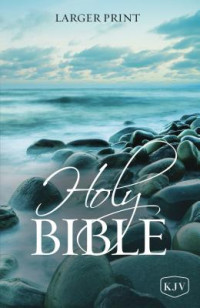What is the King James Version (KJV) Bible?
Aaron Lewendon - Eden Bibles & Bible Study Specialist
Finding the right Bible isn’t easy. There are dozens of translations and hundreds of editions to choose from. Our new series of guides is here to answer your questions about the different Bibles on offer today.

The King James Bible wasn't the first Bible to be written in English, but it is the one which has had the most impact.
For over 400 years the King James Version Bible (KJV) gave English-speaking Christians the opportunity to hear the Bible in their own words.
Known also as the Authorised Version of the Bible, the KJV is a translation of the Bible that was commissioned by King James I in response to issues the Puritans had with earlier versions. It also had to conform to the beliefs of the Church of England at the time. The creation of the KJV Bible took seven years, and six panels of translators which consisted of 47 men in total.
Celebrated for both it’s accuracy and literary excellence, it is now seen by many as an exemplary text of English Literary merit of the time. So much so that is rivals the works of John Milton and William Shakespeare. It also takes pride of place for many as the translation of the Bible which best adheres to the message at the heart of the text itself.
History of the KJV
Though not the first English language Bible to have been created - that honour goes to the Great Bible, commissioned in 1539 by Thomas Cromwell and worked on by Myles Coverdale - the King James Bible remains as the foundational Bible in the English speaking world.
The story of the King James Bible begins at Hampton Court. It was there, behind the majestic towers and impressive gatehouses which continue to greet and intimidate visitors in equal measure, that the Hampton Court Conference was first convened. A meeting between the ruling Protestant leaders and the English Puritans. In attendance at this conference were representatives of the Church of England, English Puritan leaders, and the man whose name would become forever affixed to the Bible: King James I. After a plague-induced delay, the group convened on a cold February day to address a petition from the Puritans. This petition featured requests ranging from disallowing the use of rings in marriage to banning the signing of the cross in baptism. The meetings of the Hampton Court Conference lasted five days. Amongst the requests fulfilled was one that urged for a way people could know the Bible without intermediaries. This meant that the text was to be available in English rather than in Latin; a language not spoken by the laypeople of the time, reserved instead as exclusive to the monied and educated classes. If you were affluent you could read the Bible. Or anything, for that matter.
Not wanting to alienate supporters who had previously been divided by Elizabeth I’s anti-Catholic wars, James I’s drive for this new Bible broadened his base amongst the general populace (though, as with any large political actions, more extreme-minded amongst the Puritans and Catholics of the time did not view this new Bible commission favourably).

Although this newly-commissioned Bible was sparked by Puritan complaint, the translators were still instructed to limit the amount of influence said Puritans had upon the text. The King James Bibles was to be a Bible for the general English speaking populace, not just the Puritans of the country. Other instructions included keeping the language familiar to its readers, and to not feature any margin notes (unlike other Bibles at the time).
Work on the Bible began in 1604 and ended in 1611. It then went to the King’s Printer who put it together as the complete folio. Unlike previous editions, the King James Bible didn’t feature illustrations throughout. Also, on its title page read the line ‘Appointed to be read in churches’. This Bible was not to be a feature of ornamentation or material majesty. It existed to remove the barriers to hearing God’s word and left the duty of majesty to the words of the Bible instead.
To this day, the King James Bible is a leading translation for Christians and the cornerstone text of the Church of England.
How was it Translated?
As few English language Bibles existed at the time, the King James Bible did not have a wealth of contemporary sources from which to draw. Not at all like today, where the number of available translations could fill a small library. Amongst those available in the 17th century were the Great Bible, the Geneva Bible, and the Bishop’s Bible. The latter of the three served as the primary influence for the KJV as it was produced under the Church of England a little over 50 years prior. All passages in the Bishop’s Bible deemed problematic at the time were changed, but names of places and people remained unaltered.
The translation also heavily drew from original Greek, Aramaic and Hebrew texts. These included the Hebrew Masoretic Text (the closeness to which set the KJV apart from other Bibles at the time) and Beza's Greek New Testament.
How Accurate is the KJV Bible?
For many, the King James Bible is the most authoritative and accurate text of the Bible. That doesn’t mean, however, that it adheres word-to-word to original manuscripts. Whilst the KJV sits on the more accurate side of the biblical translation scale, it was still commissioned with a purpose and audience in mind. The written style remains a significant factor in the King James Bible.
But how accurate is it, really?
Before answering, it helps to know two key terms used when discussing how accurate a Bible is. Whenever someone discusses Bible Translation accuracy, they will most likely draw a line in the sand between Bibles which are “word-for-word” and Bibles which are “thought-for-thought”.
Word-for-word Bibles present as directly as possible the text in the original scriptures. As the scriptures come from a culture far removed from our own, their texts are harder to understand and so any direct translations themselves require of the reader a sharp eye and working knowledge of the context from which the Bible came.
Thought-for-thought Bibles operate under a different approach. They employ a greater level of textual interpretation throughout their translation process. This includes taking in wider contexts and meanings as a guide to what the original text meant and how that text would appear in today’s language.
If word-for-word is akin to Google Translate, operating with as little human interpretation as possible, then thought-for-thought is like a poem translated from another language, where meaning and form carry greater emphasis.
But where does the KJV Bible sit on this spectrum?
The King James Bible sits firmly on the Word-for-Word side of things. It doesn’t feature the up-to-date scholarship of the ESV Bible, but does it hold closer to the text's original language and archaic terms. Unlike, for example, the Message Bible, whose paraphrase style works to present you with a Bible in today's language.

How Easy is the KJV to Read?
The KJV Bible text scores at a 12th Grade Reading Level. This means that readers from the ages of 17 and up should be able to confidently read the majority of the KJV text and roughly understand what it means.
What determines this level is the total number of unique words and sentences, as well as sentence length and the length of the words themselves. Other grammatical features also carry weight in the score. The reading level doesn’t take into account any understanding of history and context. Just the words and grammar of the text.
As an example, this sentence you are currently reading would score at a Grade Nine on the readability test.
This sentence would be at Grade Two.
Common Uses
Few areas of Christian and cultural life remain untouched by the King James Bible. To this day, leading literary and cultural figures such as Melvyn Bragg champion the King James Bible, citing its influence upon writers, philosophers, historians, as well as many others. And much like the works of Shakespeare, many of the phrases we use today have had their origins traced to the KJV Bible. A thief in the night, and eye for an eye, fight the good fight, scapegoat, the skin of my teeth. These and dozens more are first found in the King James Bible.
Beyond cultural impact, many Christians today hold the KJV as their Bible of choice. So much so that there is a King James Only movement which proclaims the text as the sole received text of God’s word in English.
Countless churches still use the KJV Bible in their services, as well as Christians looking for a richer Bible reading experience.
Different Editions
To this day, little of the KJV Bible has changed. So little, in fact, that many editions label themselves as the ‘1611 Authorised Version’. That doesn’t mean different editions don’t exist. Only that they didn't fall into popular use like the Authorised Version. Both the University of Oxford and the University of Cambridge looked to producing updated texts of the KJV Bible, released in 1760 and 1769, respectively.
When discussing different editions of the KJV Bible, one stands out above the rest: the New King James Version of the Bible. The NKJV was first published in 1982, partially in response to the new Bibles being released at the time. You can read more about the NKJV Bible here.
Example verses from the KJV Bible:
For God so loved the world, that he gave his only begotten Son, that whosoever believeth in him should not perish, but have everlasting life. - John 3:16
For I know the thoughts that I think toward you, saith the Lord, thoughts of peace, and not of evil, to give you an expected end. - Jeremiah 29:11
And be ye kind one to another, tenderhearted, forgiving one another, even as God for Christ's sake hath forgiven you. - Ephesians 4:32
Versions You Can Buy
Wherever Bibles are sold, you will most likely be buying the 1611 edition of the KJV Bible, but that doesn’t mean you don’t have a choice in which KJV Bible is right for you. Some of the most popular KJV Bibles people buy and read and love include:
Holy Bible: King James Version
Presented simply and handsomely, this edition of the King James Bible strives for timelessness. It’s bonded leather cover, sturdy slipcase and clear text makes this Bible a lasting companion. This edition also features a presentation page. Ideal as a thoughtful and meaningful Christian gift.
KJV Giant Print Bible
Clear without holding it near, this giant print edition of the King James Bible helps make reading the text as comfortable as possible. This is thanks to its generous 14pt text size. As well as the large text, this edition features gilt edges, imitation leather cover, ribbon marker and the words of Christ in red.
KJV Holy Bible Larger Print Paperback

An affordable entry point for anyone wanting to try out the King James Bible for the first time. This paperback edition features an easy-to-read 10.5pt font size and is available for £3.99.
The Bible: King James Version Hardback
With an introduction from Archbishop of Canterbury Justin Welby, this full-text edition of the ever-popular Authorised King James Version Bible includes both the Old and New Testaments, with all its literary beauty and poetic grandeur. A simple and timeless way to read the King James Bible.
Frequently asked questions
Every day, people turn to the Bible for questions about faith, life, meaning, Christianity and countless other topics. But as well as having questions for the Bible, there are also many questions asked about the Bible. Here we’ll try to answer some of those most asked questions.
How many words are in the King James Bible?
According to wordcounter.io, there are 783,137 words in the KJV Bible.
Who wrote the King James Bible?
A committee of 47 translators and scholars commissioned by King James I created the King James Bible in the wake of the Hampton Court Conference.
Do methodists use the King James Bible?
Yes, Methodists, as well as many other branches of Christianity, use the King James Bible regularly.
Did Shakespeare write the King James Bible?
Whilst displaying the same literary power and style of the works of William Shakespeare, the Bard himself was not amongst those who wrote the King James Bible.
Other Bible Translations:
Click on any of the images below to learn all about the stories behind some of the world's most widely-read Bible translations.






.jpg)
Latest Blogs

Gifts
Finding Your Symbol of Faith: A Guide to Christian Cross Necklaces
Looking for the perfect symbol of faith? Explore our guide to Christian cross necklaces, from rustic wooden designs and sturdy men's chains to elegant silver pendants.

Gifts
The Best Christian Gifts for Under £20
Looking for a meaningful gift that won't break the bank? Explore our guide to the best Christian gifts under £20, from inspiring journals to beautiful home decor.

Gift Guide
15 Confirmation Gift Ideas for Boys and Girls
Celebrating a confirmation? Discover 15 meaningful gift ideas for boys and girls, from youth Bibles and jewellery to inspiring journals and keepsakes.

Bible
30+ Powerful Quotes About the Bible (For Inspiration in 2026)
Looking for inspiration? Discover a curated collection of the most powerful quotes about the Bible, from famous historical figures to modern theologians and Scripture itself.

Bibles
What is the "Standard" Bible for Christians?
Is there an "official" Bible that all Christians use? We explain the difference between the NIV, KJV, and ESV, and help you find the standard text for your church or personal reading.

Bible
"I Keep Failing to Read the Bible" – 5 Tips to Make the Habit Stick
Do you start a Bible reading plan only to quit a few weeks later? Stop the cycle of guilt. Here are 5 psychological tips and practical changes to help you build a Bible habit that actually lasts in 2026.
